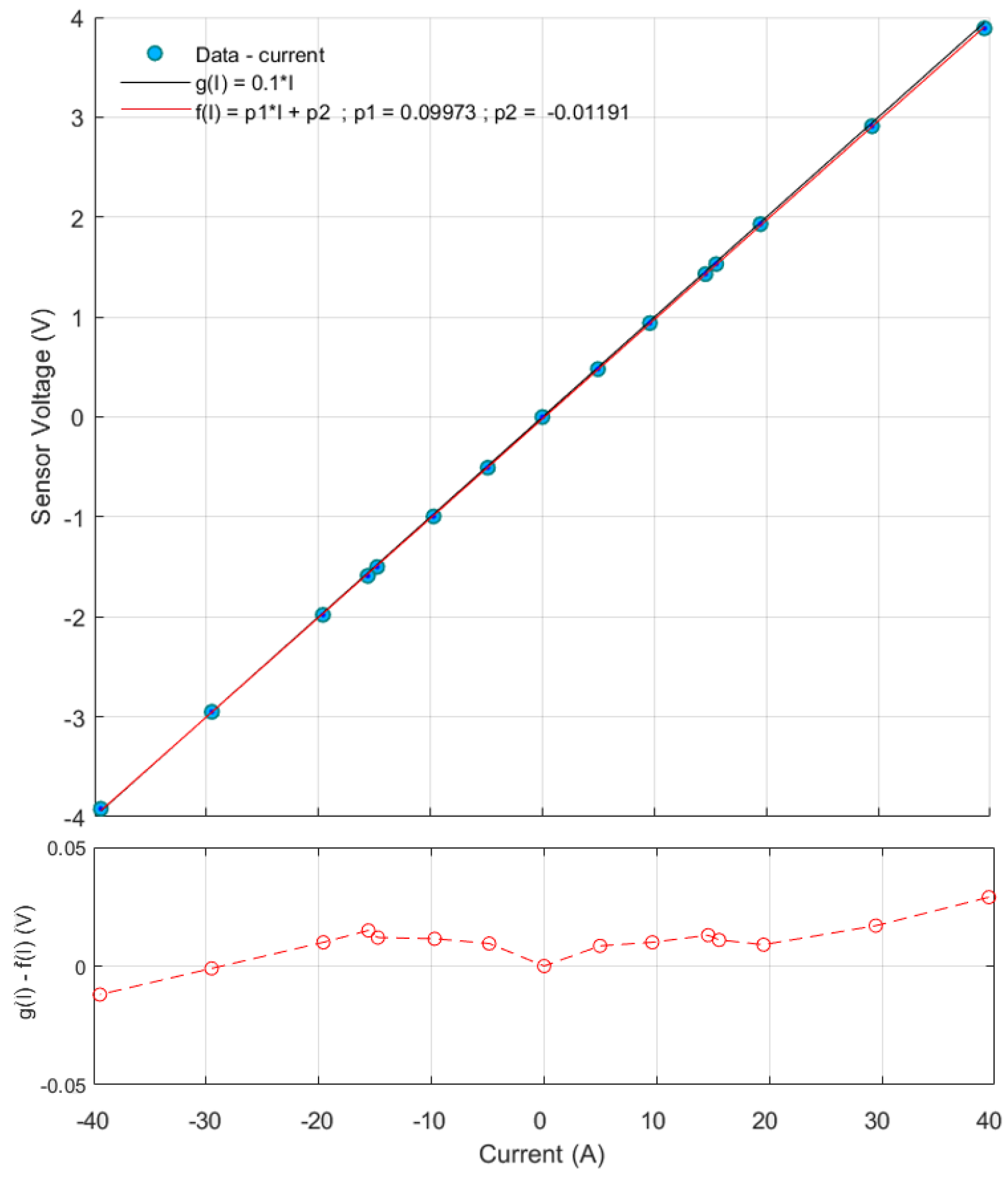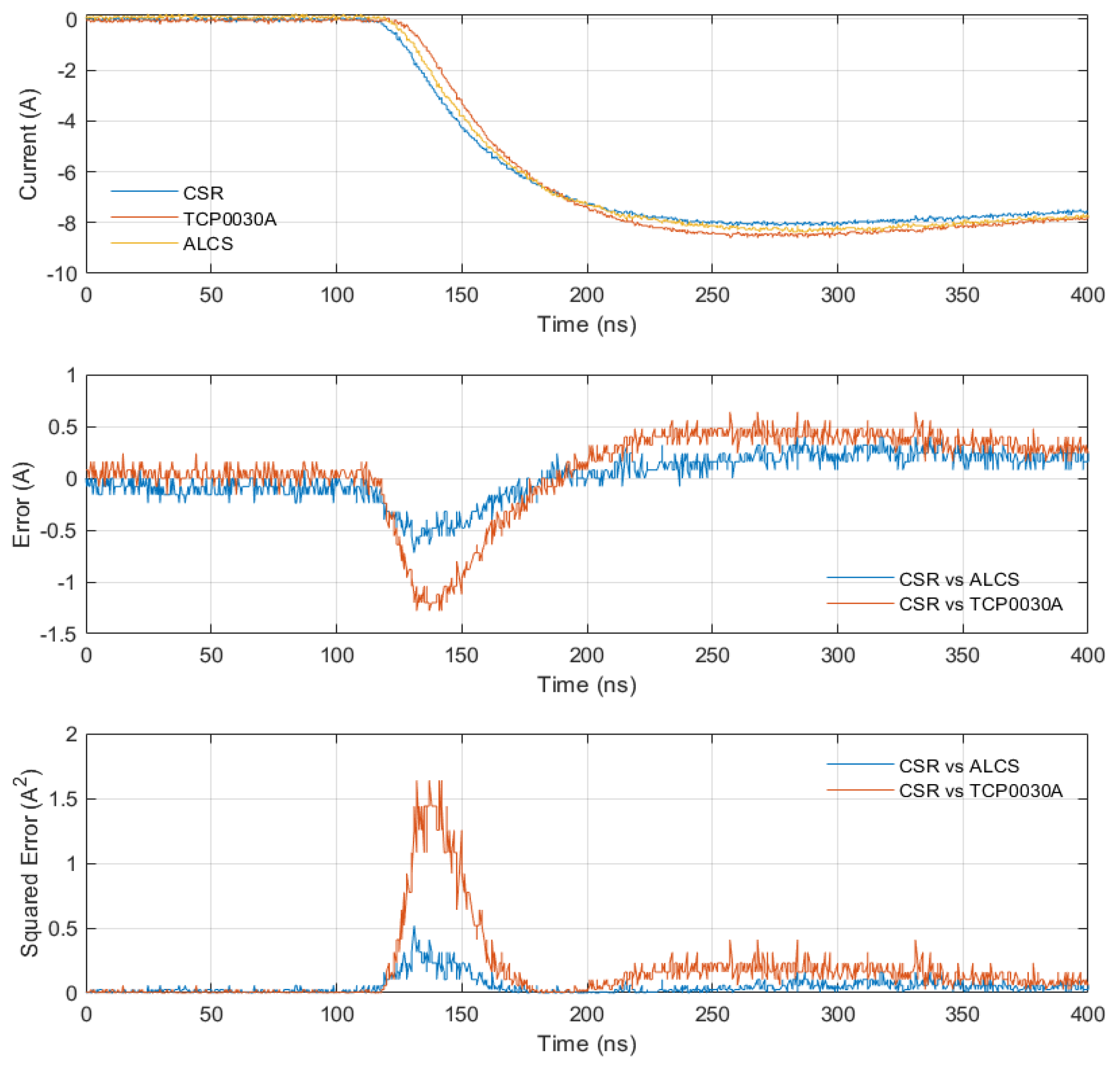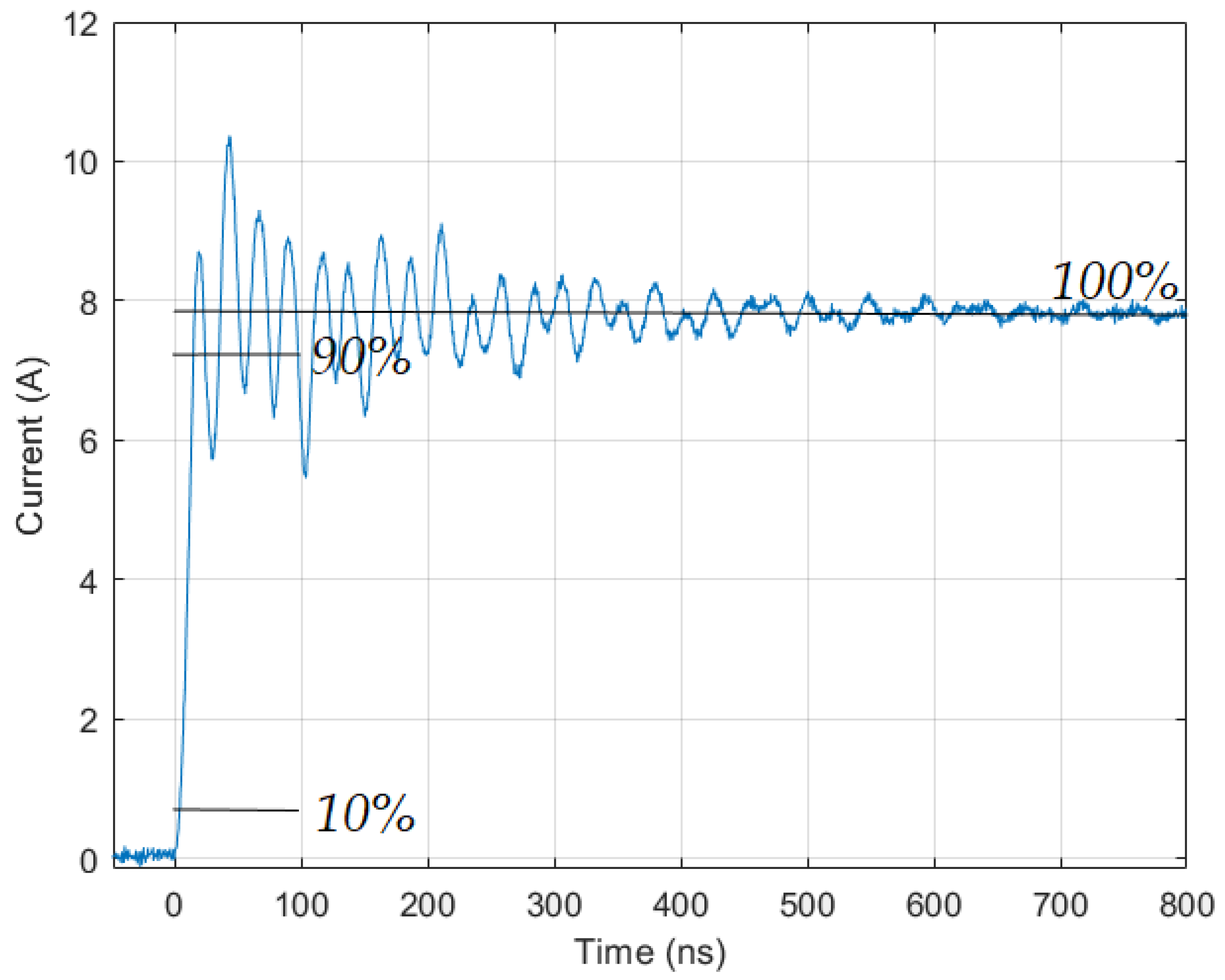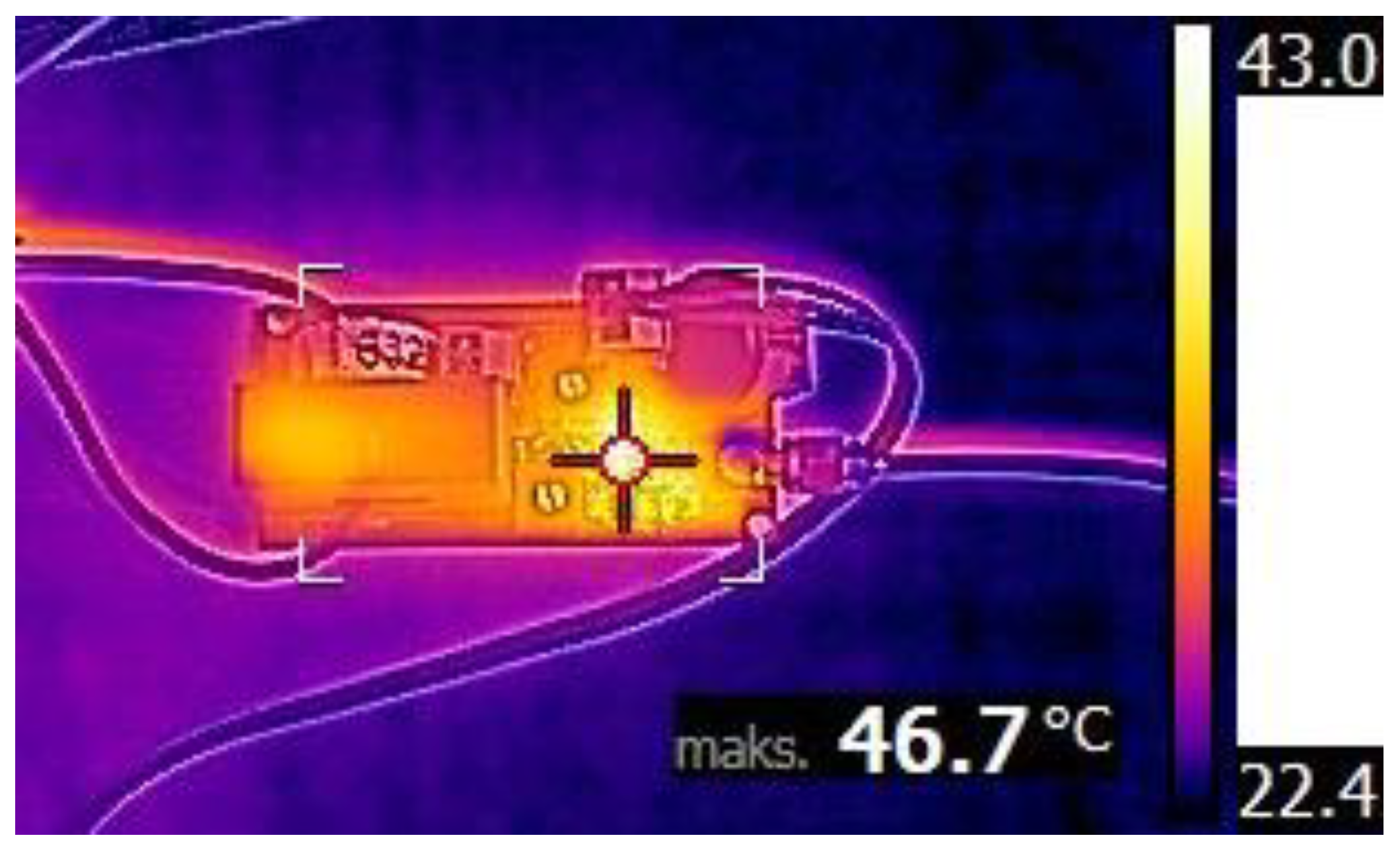Wide Bandwidth and Inexpensive Current Sensor for Power Electronics—An Augmented LEM Current Sensor
Abstract
:1. Introduction
2. Analytical Description of the Proposed Sensor
2.1. Principle of Operation
2.2. Hall-Based Sensor Model
2.3. Current Transformer Model
3. Practical Realization of the Probe and Simulation Results
3.1. Practical Realization
3.2. Simulation Analysis
4. Experimental Results
4.1. Static Characteristic
4.2. Dynamic Characteristic
4.3. Time-Domain Bandwidth Investigation
4.4. Temperature Analysis of the Steady State
5. Conclusions
Author Contributions
Funding
Institutional Review Board Statement
Informed Consent Statement
Conflicts of Interest
References
- Costa, F.; Poulichet, P.; Mazaleyrat, F.; Laboure, E. The current sensors in power electronics, a review. EPE J. 2001, 11, 7–18. [Google Scholar] [CrossRef]
- Pogliano, U.; Bosco, G.C.; Serazio, D. Coaxial Shunts as AC–DC Transfer Standards of Current. IEEE Trans. Instrum. Meas. 2009, 58, 872–877. [Google Scholar] [CrossRef]
- Filipski, P.S.; Boecker, M.; Garcocz, M. 20-A to 100-A AC–DC Coaxial Current Shunts for 100-kHz Frequency Range. IEEE Trans. Instrum. Meas. 2008, 57, 1637–1641. [Google Scholar] [CrossRef]
- Zhang, W.; Zhang, Z.; Wang, F.; Brush, E.V.; Forcier, N. High-Bandwidth Low-Inductance Current Shunt for Wide-Bandgap Devices Dynamic Characterization. IEEE Trans. Power Electron. 2021, 36, 4522–4531. [Google Scholar] [CrossRef]
- Kondrath, N.; Kazimierczuk, M.K. Bandwidth of Current Transformers. IEEE Trans. Instrum. Meas. 2009, 58, 2008–2016. [Google Scholar] [CrossRef]
- Cataliotti, A.; di Cara, D.; di Franco, P.A.; Emanuel, A.E.; Nuccio, S. Frequency response of Measurement Current Transformers. In Proceedings of the 2008 IEEE Instrumentation and Measurement Technology Conference, Victoria, BC, Canada, 12–15 May 2008; pp. 1254–1258. [Google Scholar] [CrossRef]
- Rodrigo-Mor, A.; Muñoz, F.A.; Castro-Heredia, L.C. Principles of Charge Estimation Methods Using High-Frequency Current Transformer Sensors in Partial Discharge Measurements. Sensors 2020, 20, 2520. [Google Scholar] [CrossRef] [PubMed]
- Luo, G.; Zhang, D. Study on performance of developed and industrial HFCT sensors. In Proceedings of the 2010 20th Australasian Universities Power Engineering Conference, Christchurch, New Zealand, 5–8 December 2010; pp. 1–5. [Google Scholar]
- Li, H.; Beczkowski, S.; Munk-Nielsen, S.; Lu, K.; Wu, Q. Current measurement method for characterization of fast switching power semiconductors with Silicon Steel Current Transformer. In Proceedings of the 2015 IEEE Applied Power Electronics Conference and Exposition (APEC), Charlotte, NC, USA, 15–19 March 2015; pp. 2527–2531. [Google Scholar] [CrossRef]
- Ahmed, A.; Coulbeck, L.; Castellazzi, A.; Johnson, C.M. Design and test of a PCB Rogowski coil for very high dI/dt detection. In Proceedings of the 2012 15th International Power Electronics and Motion Control Conference (EPE/PEMC), Novi Sad, Serbia, 4–6 September 2012; pp. DS1a.2-1–DS1a.2-4. [Google Scholar] [CrossRef]
- Sun, C.; Wen, Y.; Li, P.; Ye, W.; Yang, J.; Qiu, J.; Wen, J. Self-Contained Wireless Hall Current Sensor Applied for Two-Wire Zip-Cords. IEEE Trans. Magn. 2016, 52, 8600204. [Google Scholar] [CrossRef]
- Xu, C.; Liu, J.; Zhang, Q.; Xu, C.; Yang, Y. Investigation of the thermal drift of open-loop Hall Effect current sensor and its improvement. In Proceedings of the 2015 IEEE International Workshop on Applied Measurements for Power Systems (AMPS), Aachen, Germany, 23–25 September 2015; pp. 19–24. [Google Scholar] [CrossRef]
- Weiss, R.; Itzke, A.; Reitenspieß, J.; Hoffmann, I.; Weigel, R. A Novel Closed Loop Current Sensor Based on a Circular Array of Magnetic Field Sensors. IEEE Sens. J. 2019, 19, 2517–2524. [Google Scholar] [CrossRef]
- Dalessandro, L.; Karrer, N.; Kolar, J.W. High-Performance Planar Isolated Current Sensor for Power Electronics Applications. IEEE Trans. Power Electron. 2007, 22, 1682–1692. [Google Scholar] [CrossRef]
- Dalessandro, L.; Karrer, N.; Kolar, J.W. A novel isolated current sensor for high-performance power electronics applications. In Proceedings of the Twenty-First Annual IEEE Applied Power Electronics Conference and Exposition, Dallas, TX, USA, 19–23 March 2006; p. 8. [Google Scholar] [CrossRef]
- Burkhard, U. Open-source wideband (DC to MHz range) isolated current sensor. HardwareX 2019, 5. [Google Scholar] [CrossRef]
- Ziegler, P.; Tröster, N.; Schmidt, D.; Ruthardt, J.; Fischer, M.; Roth-Stielow, J. Wide Bandwidth Current Sensor for Commutation Current Measurement in Fast Switching Power Electronics. In Proceedings of the 2020 22nd European Conference on Power Electronics and Applications (EPE’20 ECCE Europe), Lyon, France, 7–11 September 2020; pp. 1–9. [Google Scholar] [CrossRef]
- Li, K.; Videt, A.; Idir, N. GaN-HEMT fast switching current measurement method based on current surface probe. In Proceedings of the 2014 16th European Conference on Power Electronics and Applications, Lappeenranta, Finland, 26–28 August 2014; pp. 1–10. [Google Scholar] [CrossRef]
- Allegro, MycroSystems, Inc. Linear Hall Sensors. 2005. Available online: https://www.allegromicro.com/en/products/sense/current-sensor-ics/zero-to-fifty-amp-integrated-conductor-sensor-ics (accessed on 20 May 2021).
- Silicon Laboratories. Si8920 Data Sheet. Available online: https://www.silabs.com/ (accessed on 20 May 2021).
- LEM. Current Transducer LA 55-P 17 September 2018. Available online: https://www.lem.com/ (accessed on 13 May 2021).
- Tektronix, Inc. TCP0030A Datasheet 30 A AC/DC Current Probe. Available online: https://www.tek.com/datasheet/30-ac-dc-current-probe (accessed on 27 May 2021).
- Coaxial Shunts T&M RESEARCH PRODUCTS, Inc. Available online: http://www.ib-billmann.de/bilder/pdf/shunts_tech.pdf (accessed on 28 June 2021).
- Pearson Electronics. Clamp on Current Monitors. Available online: https://www.pearsonelectronics.com/products/clamp-on-current-monitors (accessed on 28 June 2021).
- Power Electronic Measurements-PEM. CWT Ultra-Mini. Available online: http://www.pemuk.com/Userfiles/CWTum/CWTUM_DS_Feb_2020.pdf (accessed on 30 June 2021).
- ABB Entrelec. MP and EL Industry Current Sensors. Available online: https://search.abb.com/library/Download.aspx?DocumentID=1SBC140156C02__&LanguageCode=en&DocumentPartId=&Action=Launch (accessed on 30 June 2021).
- Analog Devices, Inc. AD8000, 1.5 GHz, Ultrahigh Speed Op Amp. Available online: https://www.analog.com/ (accessed on 27 May 2021).
- Tektronix, Inc. MDO3000 Mixed Domain Oscilloscope. Available online: https://www.tek.com/oscilloscope/mdo3000-mixed-domain-oscilloscope (accessed on 27 May 2021).
- Tektronix, Inc. TPP1000 Passive Voltage Probes. Available online: https://www.tek.com/datasheet/passive-voltage-probes (accessed on 27 May 2021).
- Nitzsche, M.; Zehelein, M.; Tröster, N.; Roth-Stielow, J. Precise Voltage Measurement for Power Electronics with High Switching Frequencies. In Proceedings of the PCIM Europe 2018, International Exhibition and Conference for Power Electronics, Intelligent Motion, Renewable Energy and Energy Management, Nuremberg, Germany, 5–7 June 2018. [Google Scholar] [CrossRef]
- Zhang, Z.; Guo, B.; Wang, F.F.; Jones, E.A.; Tolbert, L.M.; Blalock, B.J. Methodology for Wide Band-Gap Device Dynamic Characterization. IEEE Trans. Power Electron. 2017, 32, 9307–9318. [Google Scholar] [CrossRef]
- GS66508T/GS66516T-EVBDB GaN EHEMT Daughter Board and GS665MB-EVB Evaluation Platform User’s Guide. Available online: https://gansystems.com/wp-content/uploads/2018/04/GS665xxT-EVBDB_UserGuide_rev_20180126.pdf (accessed on 28 June 2021).











| Current Sensors | Name | Reference | Bandwidth [MHz] | Slope Rise Time [ns] | Capable of Measuring DC Signals | Isolation | Estimated Size | Estimated Cost | Application Constraints |
|---|---|---|---|---|---|---|---|---|---|
| CSR | SDN-414-01 | [23] | 400 | 1.0 | Yes | No | Small | Moderate (<500$) | limited energy dissipation (EMAX = 6 J) |
| SDN-414-10 | [23] | 2000 | 0.18 | Yes | No | Small | Moderate (<500$) | limited energy dissipation (EMAX = 1 J) | |
| Not reported | [3] | 0.1 | Not reported | Yes | No | Large | Not reported | 20 A to 100 A | |
| SMDCSR | [4] | 2230 | Not reported | Yes | No | Small | Not reported | limited energy dissipation and SMD mount | |
| HFCT | Pearson Model 8585C | [24] | 200 | 2.0 | No (>1500 Hz) | Yes | Large | High (>500$) | Max. RMS Current 5 A |
| Pearson Model 4688 | [24] | 30 | 12 | No (>600 Hz) | Yes | Large | High (>500$) | Max. RMS Current 15 A | |
| RC | CWT015 | [25] | 30 | 42 | No (>116 Hz) | Yes | Small | High (>500$) | Peak current ±30 A and 2.0 kA/μs |
| PCB Rogowski | [10] | 10–30 | Not reported | No | Yes | Small | Not reported | Max. RMS Current not reported | |
| Hall sensor | ABB EL50P1 | [26] | 0.2 | Not reported | Yes | Yes | Medium | Low (<50$) | 50 A RMS ±80 peak to peak |
| LEM LA 55-P | [21] | 0.2 | 500 | Yes | Yes | Medium | Low (<50$) | 50 A RMS ±70 peak to peak | |
| ACS70331 | [19] | 1 | Not reported | Yes | Yes | Small | Low (<50$) | 5 A and SMD mount | |
| ACS37002MA | [19] | 0.4 | Not reported | Yes | Yes | Small | Low (<50$) | +/−100 A and SMD mount | |
| CSR + isol. amplifier | CSR with SI8920 | [20] | 0.9 | 400 | Yes | Yes | Small | Low/Moderate | Limited by CSR |
| TMR + RC | Not reported | [17] | 315 | 4.2 | Yes | Yes | Medium | Not reported | 26 A and a PCB is required |
| Hall + HFCT | DC planar-CT | [15] | 30 | Not reported | Yes | Yes | Small | Not reported | 30 A and soldering is required |
| OS sensor | [16] | 5 | Not reported | Yes | Yes | Small | Low (<50$) | 10 A and a PCB is required | |
| Current Surface Probe (CSP) | [18] | 133 | 2.5 | Yes | Yes | Medium | Not reported | Not reported | |
| TCP0030A | [22] | 120 | 2.92 | Yes | Yes | Large | Very High (>4000$) | 30 A RMS ±50 A peak to peak | |
| Proposed ALCS | 38.33 | 10.49 | Yes | Yes | Large | Low (<50$) | 40 A RMS ±40 A peak to peak |
| Element | Symbol | Theoretical Value (4), (10) and (13) | Simulation Value (Figure 4) |
|---|---|---|---|
| CT | fLF | 553.58 Hz | 579.43 Hz |
| fHF | 221.04 MHz | 225.42 MHz | |
| LEM RC filter | fHF-RC | 2513.27 Hz | 2513 Hz |
| Step-Response Characteristics | TCP0030A | ALCS |
|---|---|---|
| Response delay (RD) | 6 ns | 4 ns |
| Time delay to reach peak value (TDRPV) | 1 ns | 13 ns |
| Peak value difference (PVD) | 0.48 A | 0.24 A |
| Root Mean Squared Error (RMSE) | 0.41 A | 0.22 A |
| Mean error (ME) | 0.09 A | 0.02 A |
Publisher’s Note: MDPI stays neutral with regard to jurisdictional claims in published maps and institutional affiliations. |
© 2021 by the authors. Licensee MDPI, Basel, Switzerland. This article is an open access article distributed under the terms and conditions of the Creative Commons Attribution (CC BY) license (https://creativecommons.org/licenses/by/4.0/).
Share and Cite
Chojowski, M.; Dziadecki, A.; Baszyński, M.; Dudek, R.; Stobiecki, A.; Skotniczny, J. Wide Bandwidth and Inexpensive Current Sensor for Power Electronics—An Augmented LEM Current Sensor. Energies 2021, 14, 4194. https://doi.org/10.3390/en14144194
Chojowski M, Dziadecki A, Baszyński M, Dudek R, Stobiecki A, Skotniczny J. Wide Bandwidth and Inexpensive Current Sensor for Power Electronics—An Augmented LEM Current Sensor. Energies. 2021; 14(14):4194. https://doi.org/10.3390/en14144194
Chicago/Turabian StyleChojowski, Maciej, Aleksander Dziadecki, Marcin Baszyński, Roman Dudek, Andrzej Stobiecki, and Józef Skotniczny. 2021. "Wide Bandwidth and Inexpensive Current Sensor for Power Electronics—An Augmented LEM Current Sensor" Energies 14, no. 14: 4194. https://doi.org/10.3390/en14144194







